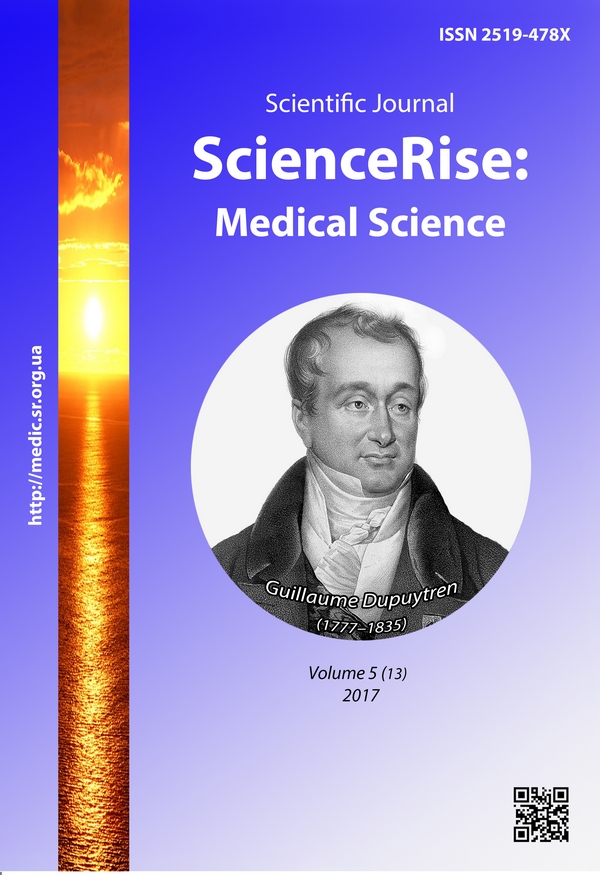Research of ultrastructure of the rat’s normal blood capillaries of thymus and its changes under influence of methyl tret-butyl ether
DOI:
https://doi.org/10.15587/2519-4798.2017.102630Keywords:
thymus, hemomicrocirculatory bed, methyl tret-butyl ether, endothelial cells, dystrophy, alteration, adaptationAbstract
Aim of research is the study of the influence of benzene component, namely methyl tret-butyl ether on the structure of hemomicrocirculatory bed of a thymus. It is known that a thymus is a central organ of the immune system that plays an important role in the formation of the immune response to endo- and exogenous antigens. In the connection of growing environmental pollution, the number of diseases, connected with immune system pathologies essentially increased. Experts think that the increase of the number of immune diseases is a result of soil contamination as an inalienable factor of life activity.
Methods of research: terms and conditions of water contamination with methyl tren-butyl ether, approximated to real ones were created for the study. The minimum for contamination is 1/1000 – 1/2000 of the mean toxic dose. Hemomicrocirculatory bed of rat’s thymus and its cells were studied under the influence of different doses (500 mg/kg; 50 mg/kg; 5 mg/kg; 0,5 mg/kg) of methyl tret-butyl ether. White laboratory rats were selected for the study because of well developed thymus and its morphological similarity to a human one.
Results: general changes of hemomicrocirculatory vessels are reactive and adaptive ones (І and ІІ stages of pathological process), dystrophic and alterative (ІІІ stage), changes of endotheliocytes and basal membrane in all links of hemomicrocirculatory bed.
The manifestation of reactive changes is the change of endotheliocytes configuration, microclasmatos and vesiculation. The adaptation of reactive changes is directed on stabilization of the endotheliocyte order. It is manifested as vesiculation transformation from the transport to membranoplastic type.
Conclusions: Morphological study of the vascular ultrastructure of hemomicrocirculatiry bed using electric transmissive microscopy proves that at methyl tret-butyl ether penetration in rat’s organism, its effect results in ultrastructural changes of the microhemocirculatory bed and has a cumulative character
References
- Yavorovs'kyy, O. P., Paustovs'kyy, Yu. O., Drobotenko, V. A. (2007). Hihiyenichna otsinka umov pratsi ta stan zdorov’ya robitnykiv, zaynyatykh vyhotovlennyam metyltretbutylovoho efiru na Lysychans'komu NPZ. Dovkillya ta zdorov’ya, 1 (40), 34–38.
- Paustovs'kyy, Yu. O. (2008). Ekolohichno-toksykolohichna otsinka hlobal'noho zabrudnyuvacha dovkillya – metyltretbutylovoho efiru (stan ta perspektyvy). Prioritetni problemy hihiyeny pratsi, profesiynoyi ta vyrobnycho-zumovlenoyi zakhvoryuvannosti v Ukrayini, 150–159.
- Dhabhar, F. S. (2009). Enhancing versus Suppressive Effects of Stress on Immune Function: Implications for Immunoprotection and Immunopathology. Neuroimmunomodulation, 16(5), 300–317. doi: 10.1159/000216188
- Moroz, G. A. (2009). Stroenie timusa inaktnyih kryis-samov linii vistar raznogovozrosta. Mir meditsinyi i biologii, 3-2 (5), 98–102.
- Parakhyn, A. A. (2010). Krovonosni kapilyary kory lobovykh chastok pivkul' velykoho mozku v normi i pid diyeyu metyltretbutylovoho efiru v eksperymenti u shchuriv. Kyiv, 19.
- Kerechanyn, I. V. (2010). Strukturni zminy sudyn hemomikrotsyrkulyatornoho rusla ta klityn tymusa pid diyeyu metyltretbutylovoho efiru v eksperymenti u shchuriv. Kyiv, 20.
- Roos, W. P., Thomas, A. D., Kaina, B. (2015). DNA damage and the balance between survival and death in cancer biology. Nature Reviews Cancer, 16 (1), 20–33. doi: 10.1038/nrc.2015.2
- Keck, M., Herndon, D. H., Kamolz, L. P., Frey, M., Jeschke, M. G. (2009). Pathophysiology of burns. Wiener Medizinische Wochenschrift, 159 (13-14), 327–336. doi: 10.1007/s10354-009-0651-2
- Vakifahmetoglu, H., Olsson, M., Zhivotovsky, B. (2008). Death through a tragedy: mitotic catastrophe. Cell Death and Differentiation, 15 (7), 1153–1162. doi: 10.1038/cdd.2008.47
- Vitale, I., Galluzzi, L., Castedo, M., Kroemer, G. (2011). Mitotic catastrophe: a mechanism for avoiding genomic instability. Nature Reviews Molecular Cell Biology, 12 (6), 385–392. doi: 10.1038/nrm3115
Downloads
Published
How to Cite
Issue
Section
License
Copyright (c) 2017 Iryna Kerechanin

This work is licensed under a Creative Commons Attribution 4.0 International License.
Our journal abides by the Creative Commons CC BY copyright rights and permissions for open access journals.
Authors, who are published in this journal, agree to the following conditions:
1. The authors reserve the right to authorship of the work and pass the first publication right of this work to the journal under the terms of a Creative Commons CC BY, which allows others to freely distribute the published research with the obligatory reference to the authors of the original work and the first publication of the work in this journal.
2. The authors have the right to conclude separate supplement agreements that relate to non-exclusive work distribution in the form in which it has been published by the journal (for example, to upload the work to the online storage of the journal or publish it as part of a monograph), provided that the reference to the first publication of the work in this journal is included.









